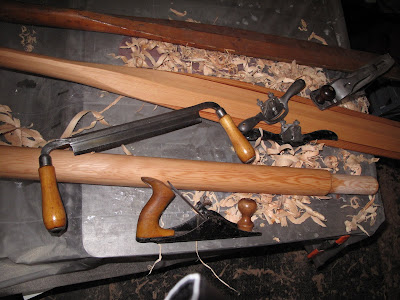

As I hitched up the boat I could hear the surf pummeling the Oregon Coast even though my house is more than a half mile from the beach. This weekend the storm-warning flags flew for the first time in months. Driving south along the coast highway the wind buffeted Ravn on the trailer.
I picked up my friend, Scott, in Newport. He brought his fishing pole and net because the salmon are running up the Yaquina River. Both of us brought our foul-weather gear.
As we drove east the wind abated, but the sky was a threatening rain. We got to Elk City around 1 p.m. to total calm and no rain, conditions that would persist until about the last mile of our row. Nine other boats were there from the Western Oregon Messabouts (the Coots) -- 14 other Coots and spouses. it was an interesting group of boats that included a Bogler Light Schooner, two canoes, a Puddle Duck Racer, a Footloose Skiff designed by Warren Jordan, a Pete Culler Good Little Skiff and a Paul Gartside Riff.
We rowed six miles down the river on a falling tide that sometimes gave us as much as a two-knot push. The salmon were jumping and rolling all along the six miles of river, but Scott didn't get a bite. Only one other boat we passed caught one and it was dark (past its prime), they said.
I rowed most of the way while Scott fished. He did try out the new oars and agreed with me that they could stand to have more wood removed from the shaft between the leathers and the blade. We rowed double for a while: four oars first, then we both sat on the same thwart and rowed one oar each. The surprising thing was that we seemed to go as fast each rowing one oar as we did under four oars. What will it be like with four rowers!?
The weather was very nice for late October, no wind or rain and about 60 degrees. Then, about a mile from our goal, a gust of wind so sudden and strong that it took your breath away struck us and it started to pour. Everyone was ready with the rain gear and no one looked too uncomfortable, but we were all ready to get out by the time we reached the Quarry Boat Launch.
Mary, who organized the event with her husband Michael (a.k.a. Doryman), ferried the drivers back to their towing rigs. Once back at the boat launch, many helpers made loading the 10 boats a quick operation.
We then went to Pigfeathers, a great little BBQ joint in Toledo. The food, the company and the service was awesome! A nice end to a great rowing event!
For more (and better) photos got to Doryman's blog and John Kohnen's photos.


























